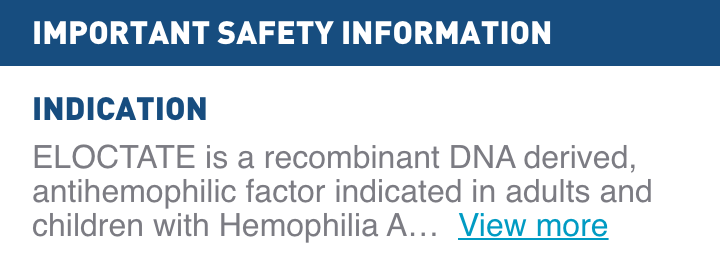ELOCTATE is contraindicated in patients who have had a life-threatening
hypersensitivity reaction to ELOCTATE or its excipients.
Hypersensitivity reactions, including anaphylaxis, have been reported with
ELOCTATE.
Clinical trial subjects were monitored for neutralizing
antibodies to FVIII
- Zero inhibitors were detected in clinical trials of PTPs
- Formation of neutralizing antibodies (inhibitors) to factor VIII has been
reported following administration of ELOCTATE
Additional warnings and precautions
- Hemophilic patients with cardiovascular risk factors or diseases may be at
the same risk to develop cardiovascular events
as nonhemophilic patients when clotting has been normalized by treatment
with factor VIII
- If a CVAD is required, risk of CVAD-related complications including local
infections, bacteremia, and catheter-site
thrombosis should be considered
Adverse reactions
PTPs: The most frequently occurring adverse reactions (>0.5% of patients) in
clinical trials were arthralgia, malaise, myalgia, headache, and rash.
-
Two subjects with cardiovascular risk factors each experienced a serious
adverse reaction of myocardial infarction during the study
The safety of ELOCTATE was studied in PUPs
Clinical trial subjects were monitored for neutralizing antibodies to factor
VIII

<6 years of age (median 0.58 year; range: 0.02–4 years)
Adverse reactions in PUPs
-
The most
frequently occurring adverse reactions (incidence
≥1% of patients) in clinical trials were factor VIII inhibition
(27.2%), device-related thrombosis (1.9%), and rash papular (1.0%)
-
The use of ELOCTATE for ITI was investigated in 15 PUPs who developed
inhibitors (12 with high-titer inhibitors and 3 with low-titer inhibitors)
-
Two subjects who experienced events of factor VIII inhibition also
experienced events of deep vein thrombosis in 1 subject and rash papular in
another subject
CVAD=central venous access device; ITI=immune tolerance induction;
PTPs=previously treated patients; PUPs=previously untreated patients.
CVAD=central venous access device; ITI=immune tolerance induction;
PTPs=previously treated patients; PUPs=previously untreated patients.

![ELOCTATE® [Antihemophilic factor (recombinant), Fc fusion protein]](assets/media/header/logo-eloctate.png)




